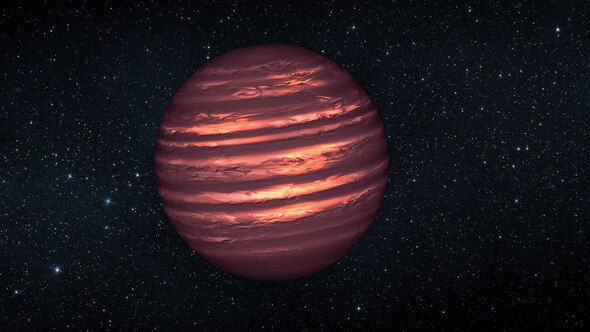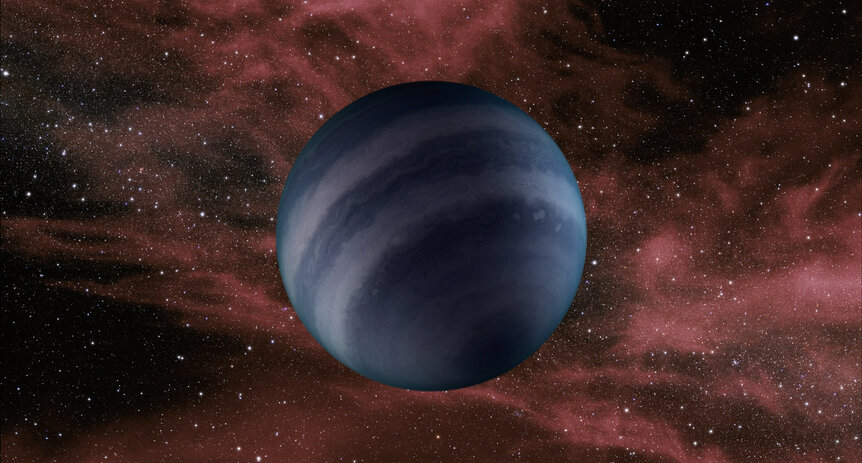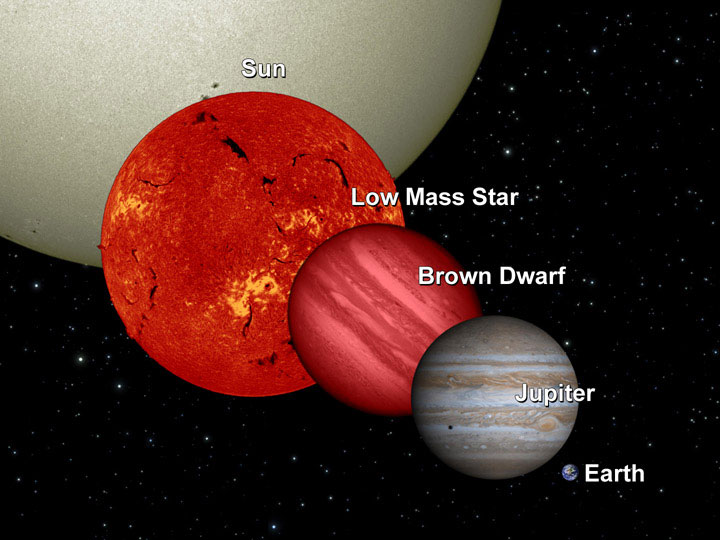Create a free profile to get unlimited access to exclusive videos, sweepstakes, and more!
A very dense oasis in the brown dwarf desert

What with all the talk of exoplanets recently, it's easy to forget about brown dwarfs. But that's not terribly fair! These are objects much more massive than planets, but which don't quite have enough mass to fuse hydrogen into helium in their cores — an object that can do that, by definition, is a star.
Some people call them failed stars, which I don't like. Maybe they're just overachieving planets!
The upper limit to the mass of a brown dwarf is about 80 times that of Jupiter (or, if you prefer, about 0.08 times the mass of the Sun). That's not hard-and-fast; under some conditions brown dwarfs can be more massive than that, but as a rough number it works.
The lower limit is harder to define. Once you get up to about 13 times Jupiter's mass, an object can fuse deuterium (an isotope of hydrogen) in its core, though this doesn't last long. Still, it's a decent place to make a cutoff, so we say that an object with a mass between 13 and 80 Jupiters is a brown dwarf.
The first true brown dwarf, Teide 1, was discovered in 1995, and the second, Gliese 229b, was found around the same time. Since then we've discovered several thousand more.
As more were found, many isolated and many orbiting "normal" stars, an interesting trend was seen: Essentially none were found orbiting their host star less than about 450 million kilometers out (three times the distance of the Earth from the Sun). This is called the brown dwarf desert, and a lot of astronomers have argued over its meaning. Maybe brown dwarfs don't form that close in. Maybe they form farther out, but unlike planets can't move in closer to their host star. One team of astronomers noted that the "driest" part of the desert, where essentially no brown dwarfs are seen, are where the dwarf mass is between 35 and 55 Jupiters, and with periods less than 100 days.
And some astronomers have said maybe this desert isn't a real thing. Maybe it's just really hard to find stellar companions like that, and so we just don't see them.
This is still unclear. But, in a new paper just published, astronomers have announced they found a brown dwarf smack in the middle of the "desert" region.
The brown dwarf (let me call them BD for short) is called EPIC 212036875b (let's say EPIC 212b, because my fingers are already tired typing that out), and was discovered in data from the Kepler space telescope, designed to look for exoplanets. It's about 1,000 light years away, and it orbits a star that's much like the Sun, though somewhat more massive and hotter.
EPIC 212b is a fascinating object. It was seen to transit its host star, passing directly in front of it as seen from Earth. The amount of light it blocks gives its size, which is about 0.87 times Jupiter's — so it's smaller than our own biggest planet! As it orbits the star its gravity tugs on it, and that can be detected using other telescopes, which can be used to get the mass. Observations of EPIC 212b indicate its mass is a whopping 52 times Jupiter's, putting it toward the upper end of the mass range of BDs.
Interestingly, it orbits the star in just 5.17 days — its year is less than a week. That puts it just 9 million km from the star, which is right in that "dry region" thought to exist. It's an oasis in the brown dwarf desert! It's unclear if this is just a really really rare object or if perhaps it's telling us this depleted orbital zone around stars isn't as deserty as we thought.
Scientifically this is very interesting. We still don't know how brown dwarfs form in detail; some may form like stars, collapsing directly from a gas cloud, while others may form like planets, collecting material from the disk around a star as it forms. The details of this are complex, but figuring it out will help us understand how all three of these objects form.
And while this discovery is pretty interesting, there's another aspect of it that jumped out at me as I read the paper. And I feel a little embarrassed that I hadn't thought of it before…
Let's back up a little. Take a look at the numbers for EPIC 212b again: It's 52 times Jupiter's mass, but it's smaller, at 0.87 times Jupiter's radius. Wait, what?
Normally, when you add mass to something it gets bigger. But BDs are different. Their cores are so dense that quantum mechanics rears its head, and if there's one thing about QM, it's screwy. The matter in the core of a BD is what's called degenerate, where electrons get squished together so hard they get squirreley, jiggling around really hard. The details are… complex, but in the end when you add mass to a BD it actually gets smaller.
But that means it also gets denser. Sometimes a lot denser.
EPIC 212b has 52 times Jupiter's mass. If it were the same size as Jupiter, it would 52 times denser. But it's smaller, with only 0.66 times the volume of the planet (remember, volume goes as radius cubed). When you take all this into account, it's nearly 80 times denser than Jupiter!
Jupiter is a gas giant, so its density isn't all that much, about 1.3 grams per cubic centimeter (the Earth, being made of metal and rock, is much more dense at 5.5 g/cc). But that means EPIC 212b is over 100 grams per cc! That's dense.
How dense? Well, iron has a density of 8 g/cc, so EPIC 212b is 12 times denser than iron. Wow! Think of it this way: If you scooped up a liter (a cube 10 cm on a side) of EPIC 212b and brought it to Earth, it would weigh 100 kilograms – 220 pounds! You'd have to be pretty strong just to pick it up.
And that's the average density of EPIC 212b. It's probably lower density near the surface and much higher in the core. Its core is much more dense than the Sun's core! But the Sun's core is extremely hot, and when you heat a gas it expands. If you could keep adding mass to EPIC 212b until it gained enough to start hydrogen fusion in its core, it would expand too, getting much bigger than Jupiter (though still much smaller than the Sun), which means its density would actually decrease a lot. The Sun's average density is only 1 g/cc, after all (though more like 150 in the core).
That boggles my brain. Even objects like stars aren't terribly dense, similar to planets. Sure, white dwarfs and neutron stars are much denser, but they're bizarre objects with terribly strange properties. I expect things to be weird with them.
Despite all this time reading about brown dwarfs (and even studying them for a while professionally) I still think of them as something between planets and stars, defined by their boundaries. But as the phenomenal density indicates, they are neither. Calling them failed stars or superplanets isn't fair to any of these objects, and prejudices us to think of them a certain way when they are under no obligation to behave in that manner.
I've run into this problem time and again, and I try to break free of it, so it surprises me when, as in this case, I still find it lurking around my brain. I'm glad I got this chance to once again rid my mind of those cobwebs.
And, if there's a societal moral in this episode somewhere, well, you're welcome to extrapolate this lesson to find it.
















